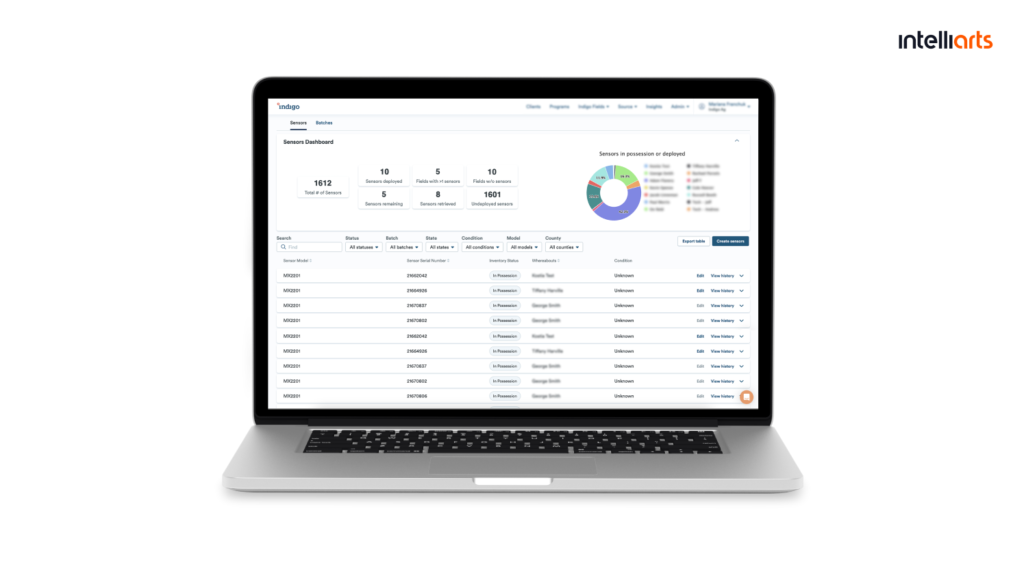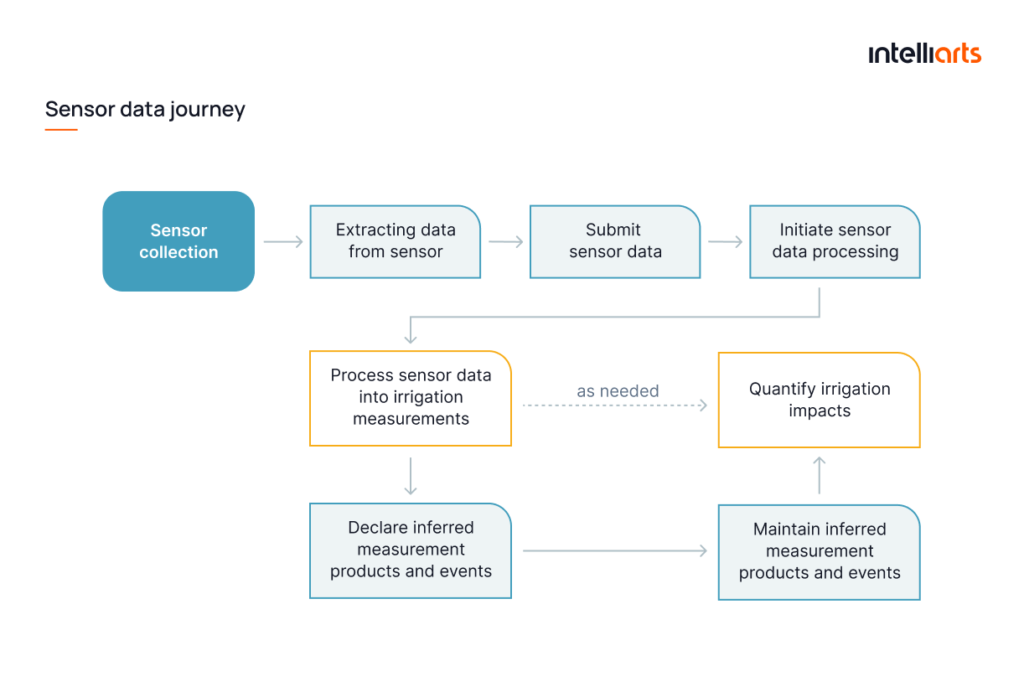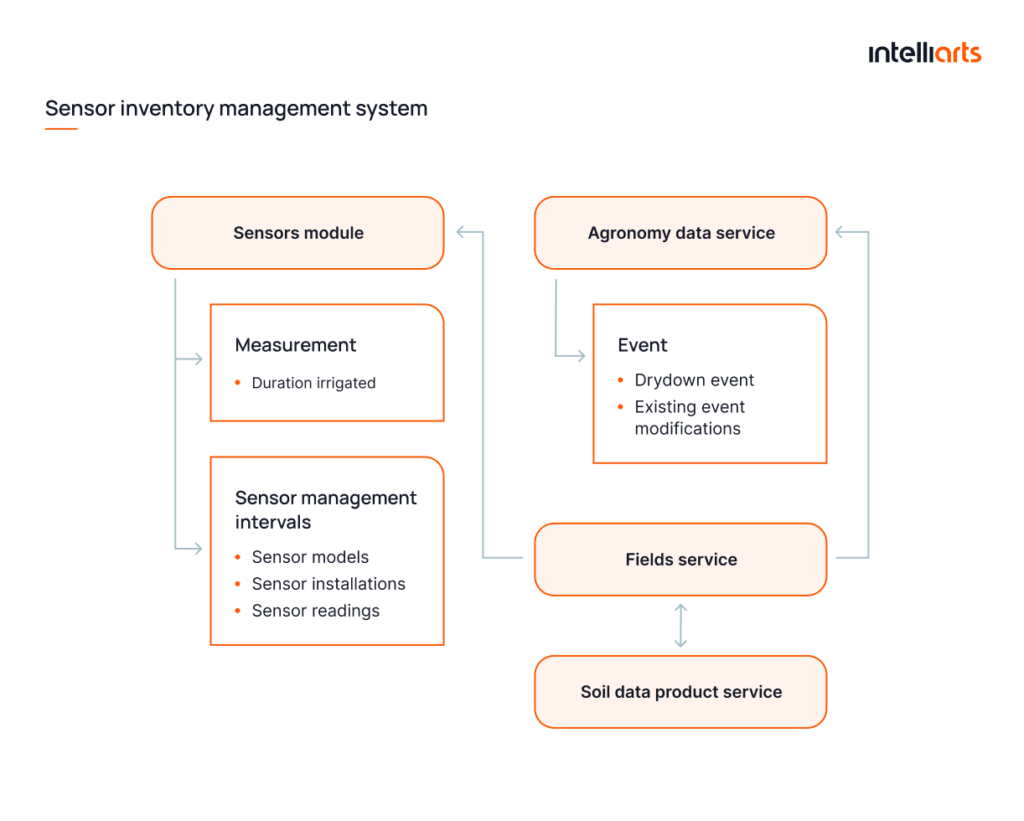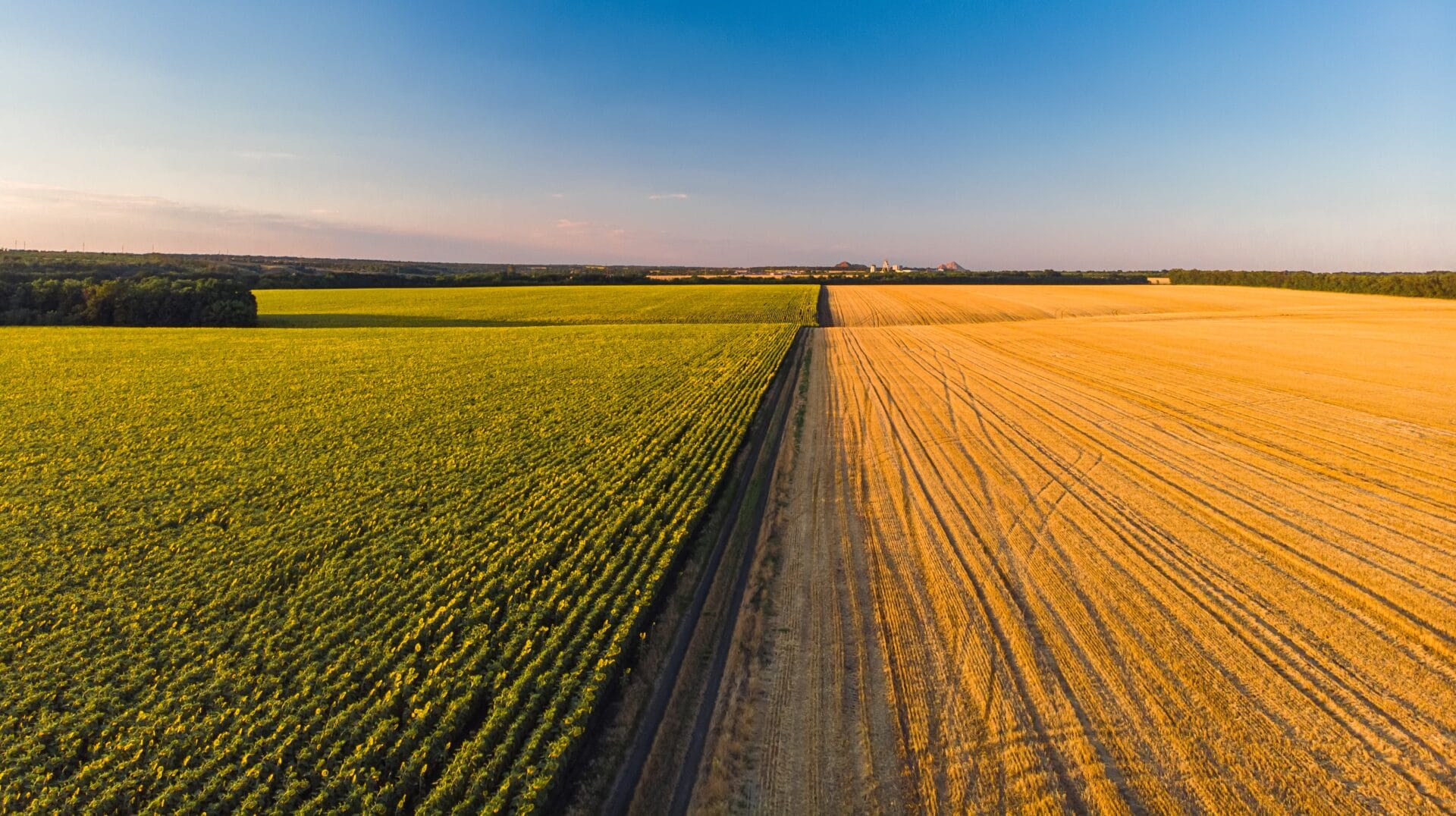Solution Highlights
- Developed a custom sensor inventory management system to streamline tracking and deployment
- Reduced time spent on manual tasks with bulk sensor management and mobile app integration
- Enabled 260% operational scaling with centralized sensor management software
- Helped to reduce water use per acre by 10 times as compared to the prior year
- Improved data accuracy and sensor reliability with integrated QA/QC checks

About the Project
Customer:
Our partner (under NDA) is an innovative agritech business that benefits from emerging technologies in agriculture to improve farm profitability and reduce environmental impact. Their suite of services is designed to optimize various aspects of agricultural production, from crop management and supply chain efficiency to sustainable farming practices.
Challenges & Project Goals:
As the company scaled progressively, its operations team met the challenge of managing sensor inventory and deployments. With almost 2000 sensors spread across over 500 fields, keeping track of sensor locations, usage, and conditions required extensive manual effort.
“The existing workflow relied heavily on Google Sheets, ad hoc dashboards, QR codes, and SQL queries. But this fragmented approach introduced mistakes in inventory tracking, delays in sensor deployment, and increased risk of human error.” — commented the company’s operations team.
Recognizing the need for automation, our partner enlisted Intelliarts’ support to design a software solution for sensor inventory management. The goal was to create a centralized system to track sensor inventory from warehouse to field and back, coordinate deployments, and improve access to sensor data.
Solution:
The new system, built from scratch by the Intelliarts team, manages the entire lifecycle of sensor usage while also providing close to real-time updates and insights for the operations and commercial teams, as well as our future partners of the company. The sensor control software offers a comprehensive UI for in-house sensor management, including:
- Sensor tracking to view and edit sensor details, such as ID, location, inventory status, serial number, etc.
- Bulk operations, such as bulk sensor uploads or batch editing to reduce manual effort when managing large inventories
- Sensor history and status monitoring to check the sensor’s deployment history, current status, or other details, such as who deployed or maintained it
- Dashboards to get an overview of sensor deployment progress, retrieval timelines, and storage status
- Integrated mobile functionality for field agents to be able to update sensor statuses directly from a mobile application while on-site
- Scalability as the system is designed to support new sensor models and future expansions
IoT Solutions, Cloud Services, Business Intelligence & Analytics
Technology Solution
Requirements gathering
The development of the sensor management system for farms began with a deep dive into the business challenge — automating the tracking and management of irrigation sensors. Our software engineers worked closely with the customer’s operations team to define their needs and understand how technology could enhance their existing process of sensor inventory management. The primary objective was to streamline inventory tracking, improve sensor lifecycle management, and enable close to real-time data updates.
System architecture and design
The next step was to establish the system infrastructure, including setting up the backend architecture to support integration with external platforms for sensor deployment, retrieval, and monitoring. When designing the system, we used REST APIs for smoother data exchange between the system and other platforms. This also added to flexibility and scalability for future updates.
We structured the core functionalities around the following key components:
- Sensor analytics: This component processes sensor data streams to analyze them and generate useful insights and data products.
- Sensor workflow management: This component automates the deployment and retrieval process to make sure that inventory management sensors in agriculture are properly tracked and actions are triggered when specific tasks are completed. It also integrates with several external systems to manage sensor workflows effectively.
- Sensor reporting: This feature offers an overview of sensor performance and status in a user-friendly format. It supports operational reporting, allowing users to learn the sensor status (installed vs. warehouse), its location, and potential performance issues.
- Service infrastructure: This part of the system provides the foundation for all core functionalities. On the one hand, it helps with the smooth operation of the sensor service. On the other hand, it contributes to easy integration with external platforms and systems.
The diagram below illustrates the sensor data journey, highlighting the key steps in the data flow — from data collection to sensor analysis.
Mobile integration
A critical part of the system was integration with a mobile application for field agents. This allowed agents to log in and update sensor information in close to real-time while on-site, keeping the data current and reducing manual updates. This way, field agents could manage their tasks more easily while the operations and commercial teams were able to track sensor statuses.
Bulk sensor management
To speed up the workflow and add more convenience, our team implemented bulk sensor management. This feature allows users to add sensors in batches using CSV uploads. It also works for batch editing to save the teams’ time spent cataloging and updating sensor information.
QA/QC checks
Maintaining data accuracy and sensor reliability was essential, so we integrated automated quality control (QA/QC) checks at key stages of the workflow. These checks helped detect and address potential issues early in the workflow to minimize the risk of faulty data entering the system. Specifically, we checked whether:
- The sensors for inventory management were correctly deployed
- The right sensor was used for a specific location
- No data was lost or corrupted during the transfer or collection process
- The sensor did not produce any data at all
- There were any issues with uploading sensor data after deployment
System integration and final implementation
With the core components in place, Intelliarts worked on deploying the system and integrating it with external platforms for sensor deployment and retrieval. Our engineers optimized the software for scalability so it could handle larger volumes of sensor data and accommodate new sensor models when this need arises.
Business Outcomes
The software solution for farm inventory management with sensors delivered by Intelliarts brought significant improvements to operational processes. By addressing key challenges, such as manual data uploads and inventory tracking, we helped improve the company’s ability to manage irrigation practices and scale their impact.
Here are the key measurable results we achieved:
- Efficiency in sensor management: The system helped streamline agricultural warehouse management with sensors and reduce time spent on manual tasks. As a result, the customer is on track to scale operations by more than 260% in the near future.
- Sensor data accuracy: Better data management, field coverage, and a more robust QA/QC increased overall data accuracy and reliability. For instance, the company experienced a 10x reduction in water use per acre as compared to the prior year. Another notable improvement was the detection of fewer irrigation events on specific fields after the system was implemented. In contrast, unreliable sensor data in the previous year forced our partner to use default assumptions about irrigation practices.
- Automation: The customer eliminated manual data uploads by building the automated system. This shift helped get rid of complex SQL databases, inconvenient Google Sheets, and ad hoc dashboards. In the long run, it also improved the operations team’s productivity by allowing them to focus on higher-priority tasks.
- Scalability: With the new system in place, the customer got an opportunity to expand their operations and serve extra fields without compromising data quality or process predictability.











